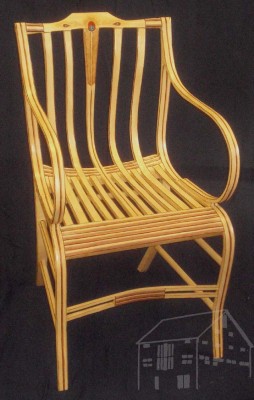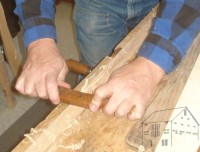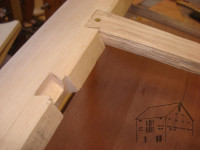The Bones of Samuel Gragg (or at least his chairs)
 One of the dreadful things about moving after three decades of living in the same place is the oppressive mass of tonnage that has accumulated, sometimes simply tucked away in a “special place” so it would not get lost. This is simultaneously distressing – it means just that more clutter to sort, dispose of or pack and move – and invigorating because every session is a new day of discovery. In cleaning out my basement shop, which even the few close friends who ever saw it tell me is claustrophobic, I have rediscovered several stashes of special wood I had set aside for unique projects yet to be built.
One of the dreadful things about moving after three decades of living in the same place is the oppressive mass of tonnage that has accumulated, sometimes simply tucked away in a “special place” so it would not get lost. This is simultaneously distressing – it means just that more clutter to sort, dispose of or pack and move – and invigorating because every session is a new day of discovery. In cleaning out my basement shop, which even the few close friends who ever saw it tell me is claustrophobic, I have rediscovered several stashes of special wood I had set aside for unique projects yet to be built.
This blog entry is not really about all of that. (I may be violating some fundamental tenet of  the blogosphere, yeah, I am sure to lose sleep over that) Instead it’s about several treasured bundles of recently harvested oak splits I had stashed out in the shed and will be on their way to The Barn this weekend. These will become Gragg elastic chairs over the next several months. I found replicating the Gragg chair to be the most challenging construction project I have undertaken, while being both aesthetic and seating delights. The chair design accommodates the human form in a broad range of configurations; I am comfortable in a Gragg chair, as is my pal Tom at 6’ 6” and my protégé Daniela at about 5’ 3” (Daniela is the artistic magician who adds the exquisite peacock feather on the center splat of the all-painted chair) Making Gragg chairs is so satisfying I intend to keep making them, and perhaps teaching the making of them, until I get tired of doing so.
the blogosphere, yeah, I am sure to lose sleep over that) Instead it’s about several treasured bundles of recently harvested oak splits I had stashed out in the shed and will be on their way to The Barn this weekend. These will become Gragg elastic chairs over the next several months. I found replicating the Gragg chair to be the most challenging construction project I have undertaken, while being both aesthetic and seating delights. The chair design accommodates the human form in a broad range of configurations; I am comfortable in a Gragg chair, as is my pal Tom at 6’ 6” and my protégé Daniela at about 5’ 3” (Daniela is the artistic magician who adds the exquisite peacock feather on the center splat of the all-painted chair) Making Gragg chairs is so satisfying I intend to keep making them, and perhaps teaching the making of them, until I get tired of doing so.
 I now have two new Gragg chair commissions and last spring I worked with my pal Tom S. to harvest
I now have two new Gragg chair commissions and last spring I worked with my pal Tom S. to harvest  some oak logs from Tom’s place and my neighbor’s yard. As I described in my article for American Period Furniture, the journal of the Society of American Period Furniture Makers, I achieved success in replicating the technology and form of Gragg only after I harvested the raw materials from the tree with my own hands. Or with Tom’s own hands.
some oak logs from Tom’s place and my neighbor’s yard. As I described in my article for American Period Furniture, the journal of the Society of American Period Furniture Makers, I achieved success in replicating the technology and form of Gragg only after I harvested the raw materials from the tree with my own hands. Or with Tom’s own hands.
Sawing to length, splitting with wedges, re-splitting, re-splitting again and again, and again, and finally riving them to manageable sizes for shaving and planing later on. Follansbee would be so proud. As long as I work them within a year or so I have found no problem with manipulating them. Since they are air dried, I could probably wait even longer if I re-moisten them but I will play with that one purposefully in the future. (By the way, if you have a source for flawless oak boles, about 24”+ in diameter by 5’ long, drop me a line)
Anyhow, these oak splits will become Gragg chairs the next winter, and their tale will be chronicled here. I hope to cut down the time required to fabricate a chair such that I can offer a course in Gragg chair-making at The Barn (I will first need beta-testing volunteers to run through it with me), and perhaps offer in The Barn Store a detailed construction and decoration manual along with full-sized drawings to establish the bending forms required to created the mostly steam-bent chair.
As soon as Tom and his family get back from a summer of frolic at their Alaska place we will get back  into the woods, to build up an inventory so I can keep cranking out this elegant and challenging piece of furniture.
into the woods, to build up an inventory so I can keep cranking out this elegant and challenging piece of furniture.
Stay tuned.
PS If you are interested and nearby, or even if you are not, I will be demonstrating the steps of making the Gragg chair at the October meeting of the Washington Woodworking Guild.



Join the Conversation!